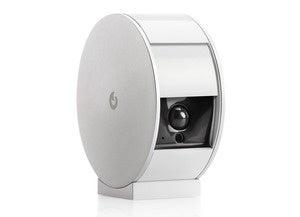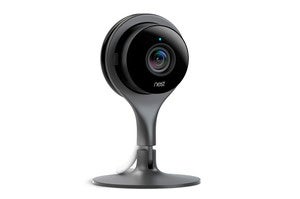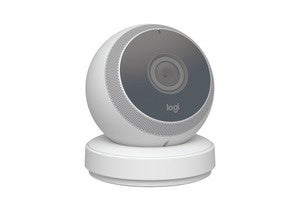Whether you rent or own, you want the best security camera system for keeping an eye on your home while you’re gone. That used to entail signing on with a professional—and pricey—security service like ADT. But a boom in consumer-level smart-home tech is putting indoor and outdoor home surveillance into our own hands.
These close cousins of webcams require minimal installation and offer flexible setups and a range of security features. Indeed, the offerings vary widely by camera, and deciding what to buy gets more daunting as this category grows ever more crowded. But whether you’re looking for an easy way to check on your kids and pets, or a full-service sentinel to monitor for intruders, we’ll help find the right product for your needs.
Updated January 27 to add our EZVIZ C8PF review. This interesting security camera uses dual lenses to deliver a picture-in-picture view in the EZVIZ app. One view can be a zoomed-in view and the other a wider angle shot. It’s not a bad idea, but it isn’t one that bowled us over either.
Most versatile home security camera
The Arlo Pro 4 offers only half the resolution of the 4K Arlo Ultra, but it’s much more reasonably priced. This new model also frees you from the requirement to buy the Arlo base station, although you can use it with that storage device if you already own one. You’ll want to also purchase an Arlo Smart Premier subscription service to unlock this camera’s 2K video resolution and copious cloud storage, but it’s an excellent value overall, and you can deploy it indoors or out.
Best premium outdoor home security camera
The price of admission for the Deep Sentinel Home Security system might seem steep at $699 ($200 more than we first reviewed the system), but it does include three outdoor cameras with two-way audio. And while the monthly subscription cost has doubled in price since our review (it’s now $100 per month), that pays for a human being to watch a live feed whenever the system’s AI detects questionable activity around your home. That person at Deep Sentinel’s facility can warn a suspicious person that they’re being observed, and they can call your local police dispatcher if the miscreant refuses to leave or engages in a criminal act. It’s not for everyone, but it’s the best DIY outdoor security camera we’ve seen to date.
Best outdoor camera for most homes
Nest has long offered some of our favorite security cameras, and the new-for-2021 Nest Cam (battery) is a versatile offering packed with great features. The camera is supremely easy to set up, and it delivers fabulous performance under any lighting condition. Also, it can be deployed indoors or out. We do wish it came with a longer cable, especially for outdoor deployments, but you’ll appreciate having three hours of event history stored on the device since you won’t have to pay for a subscription unless you want more history.
Best security camera/outdoor lighting combo
The Ring Floodlight Cam Pro is far and away the most sophisticated outdoor security camera with an integrated floodlight. Its unique 3D motion-detection feature tracks the movement of anyone that walks within its field of view and displays the path they took on an overhead map. The camera’s dual floodlights, meanwhile, will light up a large area of your home and can be programmed to turn on and off on a schedule or when motion is detected. We like it a lot.
Runner-up
The Ring Spotlight Cam is a great choice for folks who don’t want to replace their existing outdoor lighting with a camera/light combo. You don’t need to deal with bare electrical wires, you just plug it into a nearby outdoor socket. And if you don’t have one of those, you can buy a battery-operated model and trickle-charge it with a solar panel.
Best budget indoor home security camera
The EZVIZ C1C is a fabulous value. It delivers 1080p video resolution, a 130-degree field of view, excellent night vision, a microSD card slot for local video storage, and more. EZVIZ offers a reasonably priced cloud storage subscription, too, especially if you have more than one of its cameras.
Best budget outdoor security camera
Outdoor security cameras inevitably cost more than their indoor cousins, because—for starters—the need to be protected from the elements. The Wyze Cam Outdoor costs just $50, and it comes with a base station that can support up to three more outdoor cameras. The base must be hardwired to your router, but that’s a small inconvenience in relation to the value that’s delivered.
What to look for when shopping
Most home security cameras perform the same basic functions—they detect an event, record the event, and send you an alert—but they don’t all perform them the same way. And some cameras have special features that go beyond those basics. Here are some common features you’ll encounter while shopping and why they’re important (we’ve listed them in alphabetical order). In each of the reviews that follow this buyers’ guide, we’ll discuss how each camera delivers on these features.
Alerts: Home security cameras push notifications to your smartphone when they detect events. Without watching the live feed all day, this is the only way to keep tabs on your home in relative real time. Depending on the camera, it may send text alerts when it detects motion, sound, a face (known or unrecognized), or all three. Some can send alerts to multiple people, usually anyone else in the household using that product’s app; others will send emails in addition to text messages as a failsafe in the event you can’t access your mobile device.
The Flir FX’s battery backup ensures the camera will continue to operate during a power outage.
Battery backup: Power outages happen, and clever burglars cut electricity before breaking into your home. When that happens, your camera goes dark and, if there’s a crime taking place, you lose all forensic evidence. For this reason, some cameras can also run for a short time on battery power. It’s a feature worth looking for. There are also some models that run on battery power full time (you can either swap batteries as they’re depleted, or plug the camera into an AC outlet and recharge its battery that way.
Cloud recording: Many manufacturers offer cloud storage plans with their cameras. With one of these, your recorded video is sent to a remote server and stored for a predetermined time— usually anywhere from 24 hours to a week—and then deleted to make space for new videos. Though sometimes free, these cloud plans usually require a monthly subscription, but are worth it both for their convenience and if you want a surveillance record during a vacation or other extended time away from home. (See the section on HomeKit Secure Video, below, for a different approach.)
Environmental monitoring: This is the feature that sets all-in-one home monitors apart from strictly security cameras. Though the home “vitals” that these units track vary by model—we’ve seen everything from motion to luminosity included in home health profiles—three tend to be ubiquitous:
- Temperature monitors for spikes and dips in indoor temperature and alerts when it falls outside a range you define.
- Humidity tracks relative humidity inside your home. Humidity outside optimal levels—usually defined as between 30 and 50 percent—can contribute to problems such as static electricity, sinus irritation, and mold growth.
- Air quality tracks pollutants ranging from cooking odors to carbon monoxide. However, most monitors don’t identify the pollutant in their alerts, merely warning that the air quality is “abnormal.” Because of that, this feature should not be considered a substitute for potentially life-saving devices like smoke and carbon monoxide detectors.

The Netatmo Welcome supports facial recognition and can alert you when people it doesn’t recognize come within its field of view (read our review).
Facial recognition: A few newer cameras are experimenting with facial recognition. This feature could more accurately be called “facial identification,” as in practice it’s much better at distinguishing a face from, say, a lamp, than it is at actually distinguishing between one person’s face and another’s. If you opt for a camera with this feature, know that it typically learns faces through increasing exposure to them, so be prepared to spend a lot of time in front of the lens.
HomeKit Secure Video support: This is a subset of Apple’s smart-home initiative, and while you don’t necessarily need to be an avowed Apple user to benefit from HomeKit Secure Video’s privacy-enhancing features, you will need to sign up for an Apple iCloud account and have at least one of these Apple products in your home to use it: an iPad tablet, a HomePod smart speaker, or an Apple TV.
Where other types of security cameras send video to the cloud (often unencrypted), security cameras that support HomeKit Secure Video send thier video streams to one of those devices on your local network first. That device will process the video, performing tasks such as facial recognition and what have you, and then encrypting it before uploading it to your iCloud account. You can read more about HomeKit Secure Video on our sister site, Macworld.
Local storage: Some cameras include memory-card slots in lieu of, or in addition to, cloud storage, so you can store video right on the device. It’s an attractive feature as it can eliminate the cost of monthly storage fees. The downside (if there isn’t a cloud backup) is that if crooks steal your camera, they take your forensic evidence with it.
Mobile app: Most of today’s home security camera’s are accessed primarily through a smartphone/tablet app. In addition to offering you a reliable way to view the camera’s live feed, it should offer plenty of options for customizing the way the camera performs. The ability to customize notifications, adjust motion and sound detection sensitivity, and set detection areas are some of the key features to look for. The app should also be intuitive and easy to master.

Any home security camera worth its salt will support motion detection.
Motion detection: Assuming you’re monitoring your home when it’s empty, motion detection is one of the most desirable features in a security camera. Built-in sensors pick up movement within the camera’s field of view and trigger video recording.
You’ll find an in-depth explanation of how motion detection works in this article.
Because these sensors can be sensitive to any movement—even a shift in lighting or leaves blowing outside a window—it’s important the camera system also offer the ability to narrow the range of detection, adjust the sensor’s sensitivity, or otherwise customize this feature to cut down on false alerts.
Night vision: Most break-ins occur after dark, so this feature is nearly as important as motion detection. Technically, most home security cameras support infrared LED illumination, versus true night vision based on image intensification or thermal vision. Be that as it may, some camera’s will switch to night vision automatically in low-light conditions, while others allow you to customize when and how it should be activated.
Pan/Tilt/Swivel: Most security cameras can be manually tilted and swiveled to focus on a certain viewing area, but this is a purely set-it-and-forget it feature. A true pan/tilt camera is equipped with a motor so that you can move its lens—or even follow a moving object if you’re watching a live feed—using its app or browser-based app. Some cameras can even track a person moving within their field of view.

The Nest Labs Nest Cam delivers higher-than-typical 1080p video resolution.
Resolution: No amount of security video will help you if it’s blurry, jittery, or otherwise distorted. Look for a camera that offers the highest possible resolution. There was a time when 720p (often referred to as “high definition” or HD) resolution was the standard, but most newer cameras now support 1080p (often referred to as “full HD”). Some models provide even higher resoution (2K or 4K), but keep in mind that higher-res cameras use more internet and Wi-Fi bandwidth as well as battery life (where applicable). Many cameras also offer a software zoom feature (which is not the same thing as having a physical zoom lens).
Scheduling: Scheduling features allow you to tell the camera to turn on and off, detect motion, and/or send alerts at specified times. This is useful when you, say, only want to be notified when your kids get home from school or just want to monitor your home when you’re away. It also reduces the amount of false alerts. Cameras that support geofencing can do this based on the location of your smartphone, activating themselves when you leave home and turning themselves off to enhance privacy while you’re home.
Security: There have been plenty of headlines about hackers compromising home cameras, baby monitors, and other Wi-Fi devices to spy on people, so be sure to check what steps has each manufacturer taken to eliminate this problem. Look for a camera that supports up-to-date wireless security protocols, such as WPA2, and make sure it encrypts internet transmission of your user name, your password, and the live feeds. Never install a security camera (or a router or any other device on your home network) without changing its default user ID and password.
Smart device integration: If you have a home full of smart devices, consider looking for a security camera or an all-in-one home monitor that includes a Z-Wave, ZigBee, or—eventually a Thread—radio that can connect them. Support for an automation service like IFTTT is also useful. This allows the camera or monitor to react to various scenarios, such as taking a picture when your Nest Protect detects smoke, or telling your Philips Hue smart bulb to turn on when unexpected sounds are detected.

Logitech’s Circle home-security camera features two-way audio.
Two-way audio: While the idea of a security camera implies eyes-on monitoring, the ability to also hear what’s going on gives you a more complete picture of what’s happening on the home front when you’re away. It can also alert you to something occurring out of the camera’s field of vision. This feature can also allow you to speak through the camera, a great tool for remotely commanding an unruly pet or startling an intruder in the act. On some very low-end models, you might need to plug in a powered speaker for this feature to work.
Viewing angle: The camera’s field of view determines how much it can see. As you’re probably monitoring a single room, you want a wide viewing angle. Most current cameras fall in the 130-degree range. These wide angles can sometimes cause image distortion at the edges in the form of a fisheye effect, particularly when used in smaller rooms, but it’s not like you’re going to use a security to capture snapshots for your photo album.
Web client: Many cameras can be accessed through a web portal as well. This is useful for times when you don’t have access to your mobile device or a wireless connection. The web app should closely mirror its mobile counterpart, so you don’t need to learn a whole new set of controls.
Wireless range: One of the benefits wireless cameras offer is the ability to move them around your home. Ideally, your home security camera should be able to maintain a Wi-Fi connection no matter how far you move it from your router, even in a large home. Some cameras come with an ethernet port as well, so you have the option of hardwiring it to your local network. A camera that supports power-over-ethernet (PoE) eliminates the need for an AC adapter and relies on just one cable (but your router or switch will also need to support PoE. Another alternative would be to use a PoE injector.) If you’re deploying a security camera beyond the range of your Wi-Fi network, models that connect instead to the same LTE network that your smartphone relies on are a good option, but they’re generally more expensive and you’ll need to pay your cellular provider for a data plan.
Our home security camera reviews
You’ll find hands-on reviews of select home-security cameras below. Click on the product name you’re interested to go directly to that review. You’ll find a complete list of our security camera coverage here.
Ring Spotlight Cam Solar

Michael Ansaldo is veteran consumer and small-business technology journalist. He contributes regularly to TechHive and PCWorld.

